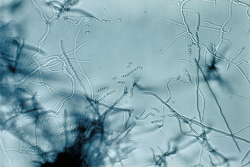Biology:Streptomycetaceae
| Streptomycetaceae | |
|---|---|

| |
| Slide culture of a Streptomyces species | |
| Scientific classification | |
| Domain: | Bacteria |
| Phylum: | Actinomycetota |
| Class: | Actinomycetia |
| Order: | Streptomycetales Cavalier-Smith 2002[2] |
| Family: | Streptomycetaceae Waksman and Henrici 1943 (Approved Lists 1980)[1] |
| Genera[3] | |
|
See text | |
| Synonyms | |
| |
Streptomycetaceae is a family of the class Actinomycetota, making up the monotypic order Streptomycetales. It includes the important genus Streptomyces. This was the original source of many antibiotics, namely streptomycin, the first antibiotic against tuberculosis.
Genomics
Sequence alignments of actinomycetotal genomes have led to the identification of three conserved signature indels which are unique to the order Streptomycetales. The enzyme PBGD contains a four-amino-acid insertion which is present in all Streptomyces species and Kitasatospora setae, but not any other Actinomycetota. Similarly, a one- amino-acid insertion is present in a conserved region of adenylate kinase and is found in all Streptomyces species and K. setae, but is not found in any other Actinomycetota. Five conserved signature proteins have also been identified which are present in various sequenced Streptomyces species, but not in K. setae; however, as the complete genome of K. setae has not yet been sequenced, these proteins may be present in K. setae. Additionally, 11 conserved signature proteins have been identified which are found in all sequenced Streptomyces species and K. setae. These proteins are believed to be unique to the Streptomycetales order, thus provide molecular markers which can be used to distinguish this group from the rest of the Actinomycetota. Phylogenetic trees indicate that the order Catenulisporales is closely related to the order Streptomycetales. This inference is supported by a one-amino-acid conserved signature indel which is uniquely found in all Streptomycetales species and Catenulisporales acidiphilia, the only Catenulisporales species whose complete genome has been sequenced. Additionally, three conserved signature proteins have been identified which are found in all Streptomycetales species and C. acidiphilia. Both the conserved signature indel and the conserved signature proteins provide evidence that the orders Streptomycetales and Catenulisporales are closely related.[4]
Phylogeny
The currently accepted taxonomy is based on the List of Prokaryotic names with Standing in Nomenclature (LPSN)[3] and National Center for Biotechnology Information (NCBI)[5]
| Whole-genome analysis[6][lower-alpha 1] | 16S rRNA based LTP_08_2023[7][8][9] | 120 marker proteins based GTDB 08-RS214[10][11][12] | |||||||||||||||||||||||||||||||||||||||||||||||||||||||||||||||||||||||||||||||||||||||||||||||||||||||||||||||||||||||||||||||||||||||||||||||||||||||||||||||||||||
|---|---|---|---|---|---|---|---|---|---|---|---|---|---|---|---|---|---|---|---|---|---|---|---|---|---|---|---|---|---|---|---|---|---|---|---|---|---|---|---|---|---|---|---|---|---|---|---|---|---|---|---|---|---|---|---|---|---|---|---|---|---|---|---|---|---|---|---|---|---|---|---|---|---|---|---|---|---|---|---|---|---|---|---|---|---|---|---|---|---|---|---|---|---|---|---|---|---|---|---|---|---|---|---|---|---|---|---|---|---|---|---|---|---|---|---|---|---|---|---|---|---|---|---|---|---|---|---|---|---|---|---|---|---|---|---|---|---|---|---|---|---|---|---|---|---|---|---|---|---|---|---|---|---|---|---|---|---|---|---|---|---|---|---|---|---|---|---|
|
|
|
Genera incertae sedis:
- "Marinispora" Kwon et al. 2006
- "Parastreptomyces" Nichols et al. 2005
- "Trichotomospora" Lian, Liu & Zhang 1985
- "Verticillomyces Shinobu 1965
See also
Notes
- ↑ Allostreptomyces is not included in this phylogenetic tree.
References
- ↑ "The Nomenclature and Classification of the Actinomycetes". J Bacteriol 46 (4): 337–341. 1943. doi:10.1128/jb.46.4.337-341.1943. PMID 16560709.
- ↑ Cavalier-Smith T. (2002). "The neomuran origin of archaebacteria, the negibacterial root of the universal tree and bacterial megaclassification". Int J Syst Evol Microbiol 52 (Pt 1): 7–76. doi:10.1099/00207713-52-1-7. PMID 11837318.
- ↑ 3.0 3.1 A.C. Parte. "Streptomycetaceae". List of Prokaryotic names with Standing in Nomenclature (LPSN). https://lpsn.dsmz.de/family/Streptomycetaceae.
- ↑ Gao, B.; Gupta, R. S. (2012). "Phylogenetic Framework and Molecular Signatures for the Main Clades of the Phylum Actinobacteria". Microbiology and Molecular Biology Reviews 76 (1): 66–112. doi:10.1128/MMBR.05011-11. PMID 22390973.
- ↑ Sayers. "Streptomycetaceae". National Center for Biotechnology Information (NCBI) taxonomy database. https://www.ncbi.nlm.nih.gov/Taxonomy/Browser/wwwtax.cgi?mode=Undef&id=2062&lvl=3&lin=f&keep=1&srchmode=1&unlock.
- ↑ "Genome-Based Taxonomic Classification of the Phylum Actinobacteria". Front. Microbiol. 9: 2007. 2018. doi:10.3389/fmicb.2018.02007. PMID 30186281.
- ↑ "The LTP". https://imedea.uib-csic.es/mmg/ltp/#LTP.
- ↑ "LTP_all tree in newick format". https://imedea.uib-csic.es/mmg/ltp/wp-content/uploads/ltp/LTP_all_08_2023.ntree.
- ↑ "LTP_08_2023 Release Notes". https://imedea.uib-csic.es/mmg/ltp/wp-content/uploads/ltp/LTP_08_2023_release_notes.pdf.
- ↑ "GTDB release 08-RS214". https://gtdb.ecogenomic.org/about#4%7C.
- ↑ "bac120_r214.sp_label". https://data.gtdb.ecogenomic.org/releases/release214/214.0/auxillary_files/bac120_r214.sp_labels.tree.
- ↑ "Taxon History". https://gtdb.ecogenomic.org/taxon_history/.
External links
Wikidata ☰ {{{from}}} entry
 |

